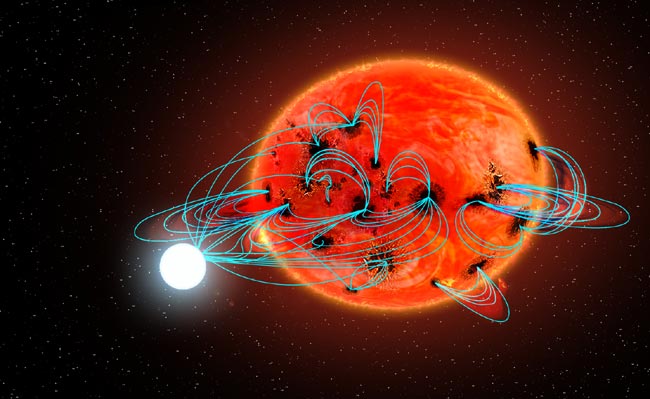Dr. Frankenstein Stars Electrify Partners

White dwarfstars locked in binary systems canspawn solar flares, spots andother activity in their otherwise calm stellar neighbors, astronomers said thisweek.
Strongmagnetic fields from the whitedwarf stars, which are burned out old stars, can provide a sort ofelectrical kick start for solar activity by reaching inside their fast-spinningpartners, researchers said.
“Like Dr.Frankenstein zapping an inert corpse, the white dwarfs in these systems producevery strong electrical currents inside the bodies of their partner star, whichcan create violent eruptions where there otherwise would be little if any,”said astronomer Stella Kafka, of the National Optical Astronomy Observatory(NOAO), who led one of two studies into the phenomenon.
Kafka andher colleagues analyzed four sets of highly energetic binary star systems,known as polars, to pin down the effects of white dwarfs on their stellarneighbors.
Theresearch was presented at a meeting of the American Astronomical Society inSeattle.
A whitedwarf is the final stage for stars lacking enough mass to end their lives inmassive stellar explosions known as supernovas.Our Sun and stars up to eight times its mass are destined to become whitedwarfs.
Whitedwarfs tend to have masses about half that of the Sun, but it's all compressed into ballwith a diameter of planet Earth.
Get the Space.com Newsletter
Breaking space news, the latest updates on rocket launches, skywatching events and more!
In polarbinary systems, white dwarfs are paired with a low-mass, cool star about the diameterof Jupiter and a mass of one-fifthor less that of the Sun. The arrangement makes for close quarters,astronomically speaking, with the two stars orbiting each other in three hoursor less.
The starsare so close that the intense magnetic field of the white dwarf actually passesthrough part of its stellar neighbor, which astronomers believe is not massiveenough to generate flares or so-called “starspots”on its own.
“Thisdiscovery points to a new mechanism for the generation of stellar activity byforces outside the star itself, a phenomenon that we have dubbed 'hyperactivity,'”said study co-author Steve Howell, an astronomer with the NOAO and WIYNObservatory at Arizona’s Kitt Peak National Observatory in Arizona.
Theresearch not only allows astronomers to better understand the interactionsbetween binary systems, but also between a close-orbiting planet and its parentstar, astronomers said.
Kafka andher colleagues studied their target binary star systems using ground-basedtelescopes at Kitt Peak and the European Southern Observatory’s Very LargeTelescope in Chile.
Editor'sNote: Allweek, SPACE.com is providing completecoverage of the 209th meeting of the American Astronomical Society.
- Top 10 Star Mysteries
- The Strangest Things in Space
- All About Stars
Join our Space Forums to keep talking space on the latest missions, night sky and more! And if you have a news tip, correction or comment, let us know at: community@space.com.

Tariq is the Editor-in-Chief of Space.com and joined the team in 2001, first as an intern and staff writer, and later as an editor. He covers human spaceflight, exploration and space science, as well as skywatching and entertainment. He became Space.com's Managing Editor in 2009 and Editor-in-Chief in 2019. Before joining Space.com, Tariq was a staff reporter for The Los Angeles Times covering education and city beats in La Habra, Fullerton and Huntington Beach. In October 2022, Tariq received the Harry Kolcum Award for excellence in space reporting from the National Space Club Florida Committee. He is also an Eagle Scout (yes, he has the Space Exploration merit badge) and went to Space Camp four times as a kid and a fifth time as an adult. He has journalism degrees from the University of Southern California and New York University. You can find Tariq at Space.com and as the co-host to the This Week In Space podcast with space historian Rod Pyle on the TWiT network. To see his latest project, you can follow Tariq on Twitter @tariqjmalik.









